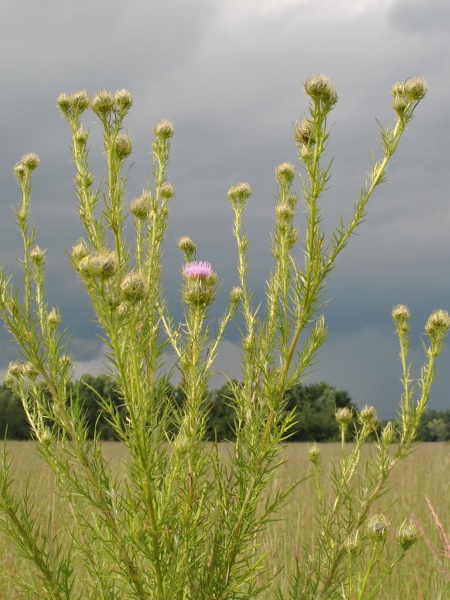
Source: Aaron Carlson
Cirsium discolor
Field Thistle
Chardon discolore
Synonyms
pasture thistle
circe discolore
No seeds available for this plant.
We currently accept seeds for this plant
Bloom Colour: Purple
Bloom Period: Aug - Oct
Max Height: 6.0 feet
Max Width: 2.0 feet (spreads by rhizome)
Light Condition:
 More than 6 hours of direct sun a day
More than 6 hours of direct sun a day
 More than 2 or 3 hours but less than 6 hours of direct sun a day
Soil conditions:
More than 2 or 3 hours but less than 6 hours of direct sun a day
Soil conditions:
 Tolerates medium soil condition
Tolerates medium soil condition
 More than 6 hours of direct sun a day
More than 6 hours of direct sun a day
 More than 2 or 3 hours but less than 6 hours of direct sun a day
More than 2 or 3 hours but less than 6 hours of direct sun a day
 Tolerates medium soil condition
Tolerates medium soil condition
Lifespan:
Biennial
plants that will take two years to bloom, and then will die
Gardener Experience:
 Does not spread uncontrollably
Does not spread uncontrollably
 Easy to germinate
Easy to germinate
 Self-seeding
Self-seeding
 Does not spread uncontrollably
Does not spread uncontrollably
 Easy to germinate
Easy to germinate
 Self-seeding
Self-seeding
Landscape Uses:
 Suitable for rock gardens
Suitable for rock gardens
 Suitable for rock gardens
Suitable for rock gardens
Ecological Benefits:
 Supports pollinators
Supports pollinators
 Butterfly host
Butterfly host
 Bee host
Bee host
 Supports pollinators
Supports pollinators
 Butterfly host
Butterfly host
 Bee host
Bee host
Tolerates:
 Tolerates limestone conditions
Tolerates limestone conditions
 Tolerates limestone conditions
Tolerates limestone conditions
Special Features and Considerations:
 This plant is endangered
This plant is endangered
 This plant produces burs
This plant produces burs
 This plant is endangered
This plant is endangered
 This plant produces burs
This plant produces burs
Plant Location
Native to Ottawa region: Yes
Distribution according to VASCAN

Ephemeral
Native
Introduced
Excluded
Extirpated
Doubtful
Absent
Thrives in Ecozones
- Atlantic Maritime
- Boreal Shield
- Mixed Wood Plains
Ecological Benefits
Butterflies Supported by Cirsium discolor
No butterfly data available for this plant.
Specialized Bees Supported by Cirsium discolor
- Megachile inimica
- Megachile pugnata
- Melissodes agilis
- Melissodes desponsus
- Melissodes subillatus
- Osmia chalybea
- Osmia texana
Plants that grow in similar conditions, that bloom at the same time.
Complementary Plants
- No complementary plants found.
Substitute For Non-Native Plants
- Cirsium arvense (Canada Thistle)
Sowing Information
Download Seed Envelope Labels (PDF)
- Sowing depth: Surface sow
- Sow by February
- Stratification duration: 60 days
- Self-seeding
Harvesting and Seed Sharing
- Harvest start month: October
- Harvesting indicator:
- Seeds easily fall off when you gently pull them off
- Harvesting:
- Shake seed head in paper bag
- Seed viability test:
- No test needed before donating
- Packaging measure: 1 rounded 1/8 teaspoon
- Seed storage:
- Air dry in paper bag or open container, for a few days until crisp
- Shake seeds to move them once in a while to prevent molding
- Cultivar: No, you can donate without knowing the source as there are only straight species
- No harvesting video available at this time.
Toxicity Notes
Inadequate information on toxicity found.


 Canadensis
Canadensis
